At a NARGS Chapter seedling sale I bought a plant of Mirabilis oblongifolia. It overwintered just fine. Taking a while to get started, this is a late summer bloomer that's just getting going at the end of August and beginning of September. I'm not sure what to make of this plant just yet, the verdict is still open. It makes a rambling tangle of long decumbent stems, from which sprout a fresh crop of small perky pink flowers each morning; the flowers short-lived and gone by early afternoon each day.
It seems that this plant is now Mirabilis albida (although flower color is variable, white, pink, rose-purple), with about 2-1/2 dozen synonyms! Does anyone else grow it, or grow it under any of the litany of synonyms? Just how big and meandering does it grow? Looks to me to be a large spreading, tangled mound, which might be hard to place in the garden effectively. The flowers are possibly not large and showy enough to justify the unkempt space it takes, although the late flowering is certainly appreciated. I might toss the plant out... what do you think?
Mirabilis albida (Mirabilis oblongifolia, just one of dozens of synonyms)
http://www.efloras.org/florataxon.aspx?flora_id=1&taxon_id=242415064
http://plants.usda.gov/java/profile?symbol=MIAL4&photoID=mial4_004_ahp.jpg
Comments
Re: Mirabilis - hardy four o'clocks
Got it same source. Seeds freely and at nearly 3x3 ft, too large for my small garden. Charles Swanson NE MA
Charles, did you get the other one that Frank Simpson had at the sale this year? I believe it is Mirabilis multiflora. Frank showed both plants growing on his side yard, and at least M. multiflora had much larger flowers, and the plant looked more "substantial" than oblongifolia. So I'll give both of them one more year to decide whether to keep or toss. I was wondering about self-sown seeding, thanks for the heads-up on that.
I don't necessarily mind the 3' x 3' plant size, but there needs to be more appeal and payback than what I'm seeing from the plant so far. I'm getting to the point that I don't want to bother growing with so-so or just-okay plants.
Re: Mirabilis - hardy four o'clocks
Mirabalis multiflora may not be for you. In my unwatered garden (okay, occasionally watered) it has a spread of easy 6' x 6'. Because this particular garden is rather large, the size is not of concern to me. I have seen it in nature in the White Mountains of California growing out of cliffs and even in that environment the size is substantial. You may want to trial it in a corner of your acreage if you have that option. In my garden it does not self seed much, in spite of the large number of seeds. I would hesitate however to plant it in a watered garden; you may get quite the opposite result (see Charles comment).
That being said, I think the flowers are quite nice as the sun sets.
Re: Mirabilis - hardy four o'clocks
The photo of Mirabilis multiflora on the Rocky Mountain Rare Plants nursery listing sure makes it look attractive!
http://www.rmrp.com/Photo%20Pages/MM/Mirabilis%20multiflora%20-%20settin...
Seed of this one is available from the current and unfortunately last seed catalog of Rocky Mountains Rare Plants.
http://www.rmrp.com/SeedCatalog/OnlineCat/index-Onlinecat.html
Also see:
http://nargs.org/smf/index.php?topic=472.0;topicseen
Re: Mirabilis - hardy four o'clocks
Mirabilis multiflora is a native on my property. Although it is completely winter-deciduous, it looks like a shrub when in full growth. I often see it growing vinelike under the native junipers (Juniperus monosperma), it seems to do best when it can reach moisture, but is not shaded. It's a traffic stopper when flowering in the middle of a grassy lot. Do not water it if you receive more than about 18" of moisture in a year. With no supplemental water and in our native clay, it retains a nice hemispherical shape, and will be covered with flowers once in the spring and again in the late summer.
I collected a bunch of seed this year from several locations on my land and during my walks along the community trail system. Unfortunately, I missed the deadline for the seedex. Seed is available for trade.
There are a couple of other Mirabilis species in New Mexico. I saw one or two of them during one of my field trips to the southern part of the state last spring. I think I found one while wandering on the other side of the highway from where I live. Seed wasn't ripe in October, and I didn't get back before snow. The other species are not nearly as showy, but may be worth growing in the right situation. I think one of them is a vine.
Re: Mirabilis - hardy four o'clocks
I was seriously looking at M multiflora at Alplains:
Mirabilis multiflora (Nyctaginaceae) (45x80,Z4,P,C,2) ......................................................... 25 seeds / $3.50
56964.19 (W) Chaffee Co., CO, 7600ft, 2317m. Huge mounds of thick cordate leaves bearing brilliant deep violet to magenta funnel-flowers. Usually found solitary or in isolated clumps. On S-facing slopes of very rocky loam.
They have an impressive photo which does not seem to be linkable; listed as Z4, but worth a try here--he has other things as Z4 which I know are doable...
Re: Mirabilis - hardy four o'clocks
Cohan, here is a link to the Alplains image of Mirabilis multiflora (internet tip, you can right-click on the photo-link to the image and select "Open Link in New Window", and it opens a whole instance of your web browser to that image; then copy the URL from the browser window).
http://www.alplains.com/images/MirabMulti.jpg
...and for comparison, the other good pick from RMRP:
http://www.rmrp.com/Photo%20Pages/MM/Mirabilis%20multiflora%20-%20settin...
Re: Mirabilis - hardy four o'clocks
Looks like a pretty impressive plant in either link--flowers seem just a touch petunia-y, which makes me wary, but probably less so in person..
Re: Mirabilis - hardy four o'clocks
I was visiting with a friend from Idaho who tells me they are growing Mirabilis macfarlanei http://www.google.com/images?hl=en&source=imghp&biw=1065&bih=675&q=mirabilis+macfarlanei&gbv=2&aq=0&aqi=g1&aql=&oq=Mirabilis+mac quite well, and that it is a superlative garden plant...very compact and floriferous and long blooming. From his spectacular pictures (which I don't have permission to show...drats!) it looks very similar to our Colorado endemic, Mirabilis rotundifolius which is restricted to a tiny range in an area that is undergoing immense impacts from mining and urban development near Pueblo Colorado. Because of its rarity (and we are stewards at Denver Botanic Gardens) we have not yet distributed this. I am hoping one day we can get the stars aligned to do so because, as you can see, it is really beautiful. It is like a compact, somewhat upright M. multiflora, only much tinier. It blooms for months on end most years (and that's without supplemental water in our dry climate). Both pictures were taken in some of our native gardens where this runs amock. What other treasures are out there?
Re: Mirabilis - hardy four o'clocks
These are nice too! More to watch for ;D
Re: Mirabilis - hardy four o'clocks
Panayoti, Mirabilis rotundifolia looks awesome! Judging from the masses blooming in the gardens at DBG, it looks to be a good garden plant too! Difficult to find photos of this rare Colorado endemic, but I did find a couple resources with photos. I cite a couple of PDF files describing this species and other plant species being watched; and in fair use, for those who might have slower connections and who might have difficulty downloading multimegabyte PDF files, I have posted a couple screen captures from one of those documents.
Mirabilis rotundifolia in Flora of North America:
http://www.efloras.org/florataxon.aspx?flora_id=1&taxon_id=242415070
Mirabilis rotundifolia (Oxybaphus rotundifolius), drawing and two low quality photos.
It seems both names are used interchangeably, although Mirabilis gets cited more often that Oxybaphus, so I'll stick with Mirabilis.
In this one the foliage looks very round, although the leaf shape is said to be variable in the species.
http://www.cnhp.colostate.edu/download/projects/rareplants/pdfs/23147.pdf
Rare Plant Surveys on Fort Carson 2006-2007, Colorado State Univ., 70 pages, 5.5 MB PDF, or click on screen capture images below.
If you like maps, this PDF document has colorful visually interesting ones; detailed distribution map of M. rotundifolia on page 63.
Some good photos of other plant taxa too.
http://www.cnhp.colostate.edu/download/documents/2007/FtCarson_FINAL1221...
Photo of M. rotundifolia seedlings; site is very slow to display non-optimized images, so again in fair use, here is a screen capture to click on in lieu of the url:
http://www.centerforplantconservation.org/collection/CPC_ProfileImage.as...
Denver Botanic Garden page on Plant Conservation, with M. rotundifolia among the list of 60 plants for which DBG are the stewards.
http://www.botanicgardens.org/content/plant-conservation
Re: Mirabilis - hardy four o'clocks
The conservation page is very interesting---very exciting work!
Re: Mirabilis - hardy four o'clocks
Have a hundred fresh seedlings in my sand bed, will try to reduce by 100 ;-)
Charles Swanson MA UA
Re: Mirabilis - hardy four o'clocks
Mirabilis expansa (Mauka) is one of the rarest root vegetables in the world, only discovered in the 1960s, and discovered being cultivated in Peru as late as 1987 and only known from 3 remote but spread areas. One of the Lost Crops of the Incas (see http://www.nap.edu/openbook.php?record_id=1398&page=75). A friend in Belgium is probably the first to trial this plant in Europe. I visited him a couple of years ago. Although not that exciting to look at, here it is:
Re: Mirabilis - hardy four o'clocks
Very interesting, Stephen! I guess it should still have showy flowers at some point? I wonder if any of the other species are edible?

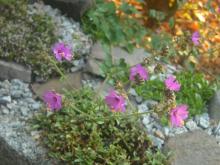
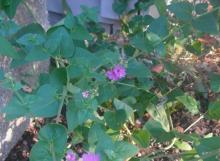


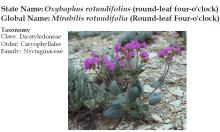
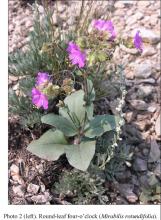

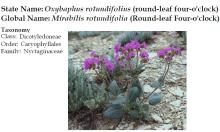
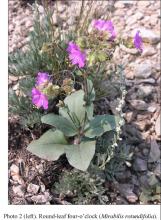

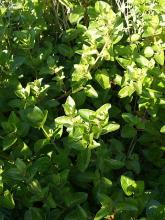
Got it same source. Seeds freely and at nearly 3x3 ft, too large for my small garden. Charles Swanson NE MA